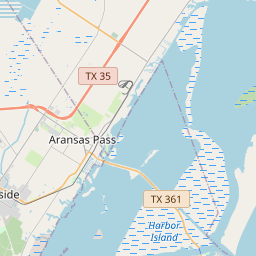Terminal Railroad
Historical marker location:






Built in 1892, the Aransas Harbor Terminal Railroad ("Old Terminal Railroad") provided a means for transporting rock from mainland quarries to jetties under construction in the pass. In 1909 the Aransas Pass Channel and Dock Company was chartered to build a channel from the first south Texas deep water port at Harbor Island to Aransas Pass. As the channel was dredged, the displaced sediment was piled along one side and became the basis for a railroad bed. Opened in 1912, the new terminal railroad extended along the roadbed and a series of eight trestles. It connected with the San Antonio and Aransas Pass railroad in Aransas Pass, and was an important cotton shipping tool. Passenger service was inaugurated with the "Toonerville Trolley", passenger coaches pulled by a converted model T Ford truck, which transported workers from the mainland to a new shipyard on Harbor Island during World War I. After Corpus Christi was designated a deep water port in 1922, business declined for Harbor Island and the railroad. In 1931 the rail line was converted to a road for automobiles, which was in turn replaced by a new highway in 1960. Hurricanes in 1961 and 1970 left few visible remnants of the terminal railroad
As one of the most visible programs of the Texas Historical Commission (THC), historical markers commemorate diverse topics in Texas history, including: the history and architecture of houses, commercial and public buildings, religious congregations, and military sites; events that changed the course of local and state history; and individuals who have made lasting contributions to the state, community organizations, and businesses.
The Johnson Space Center, located in Houston, played a crucial role in the development of the U.S. space program. It was here that NASA trained its astronauts and mission control teams, and it continues to be an important center for space research and exploration today.
By the early 19th century, Mexican settlers began to populate the area, leading to the establishment of San Patricio de Hibernia, a small community near the Nueces River. This settlement grew, becoming the county seat and a major center of commerce. However, as tensions grew between Mexico and the United States, San Patricio County became a focal point of conflict during the Texas Revolution. In 1836, local residents joined forces with Texan rebels to fight against Mexican forces in the Battle of Nueces.
After Texas gained independence from Mexico, San Patricio County continued to grow and develop. The discovery of oil and natural gas in the early 20th century brought prosperity to the area and attracted new industries. Agriculture, particularly cotton farming, also played a significant role in the county's economy. Over time, the county's population diversified, with immigrants from Ireland, Germany, and other parts of Europe contributing to its cultural heritage.
In recent decades, San Patricio County has continued to thrive, with the expansion of industrial and manufacturing sectors. The county is home to major refineries, chemical plants, and a naval air station. It has also become a popular tourist destination, with its coastal location offering beautiful beaches, recreational opportunities, and attractions such as the Copano Bay State Fishing Pier and the historic town of Sinton. Today, San Patricio County remains a vibrant community, embracing its rich history while looking toward a bright future.
San Patricio County Timeline
This timeline provides a glimpse into the major events and milestones that have shaped the history of San Patricio County, Texas.
- 1828 - The Mexican government grants land to Irish empresarios James Power and James Hewetson, leading to the settlement of Irish immigrants in the area that would become San Patricio County.
- 1836 - Texas gains independence from Mexico, and San Patricio County is officially established as a county of the Republic of Texas.
- 1870 - Railroads, including the Texas-Mexican Railway, begin operating in San Patricio County, boosting trade and transportation in the region.
- 1886 - The discovery of oil in neighboring Nueces County leads to the development of the petroleum industry in San Patricio County.
- 1927 - The town of Taft is incorporated, becoming an important center for the oil and gas industry in the county.
- 1941 - The Naval Air Station Corpus Christi is established southwest of Portland, becoming a major training base during World War II.
- 1961 - The construction of the Port of Corpus Christi's Ingleside Marine Terminal begins, further boosting the county's economic growth.
- 1970 - The completion of the Interstate Highway 37 connects San Patricio County to major transportation routes.
- 2017 - Hurricane Harvey makes landfall in San Patricio County, causing significant damage to the area.